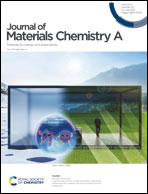Stable sodium metal anodes with a high utilization enabled by an interfacial layer composed of yolk–shell nanoparticles†
Abstract
Metallic sodium (Na) has been regarded as a promising anode for high-energy rechargeable batteries owing to its high theoretical specific capacity, low redox potential, and abundant resources. However, Na anode suffers from serious irreversibility problems, as reflected by its low coulombic efficiency (CE) and the formation of dendrites during plating/stripping. Here we report that an interfacial layer based on C@Ag nanoparticles with a well-designed yolk–shell structure is a very effective route to achieve highly reversible and dendrite-free Na anode. The yolk–shell structures of C@Ag nanoparticles integrate the advantages of the core and shell and play synergistic roles in the uniform plating/stripping of Na on cycling. This unique C@Ag interfacial layer not only enables Na plating/striping with an average CE of 99.75% for more than 2000 cycles at 1 mA h cm−2, but also allows for the Na‖Na symmetric cells to cycle for 3700 h (617 cycles) with a depth of discharge of 50% at 3 mA h cm−2 as well as for 4000 h (1000 cycles) with a depth of discharge of 33%. This finding opens up a promising way to stabilize Na anodes with a long lifespan and high safety.



 Please wait while we load your content...
Please wait while we load your content...